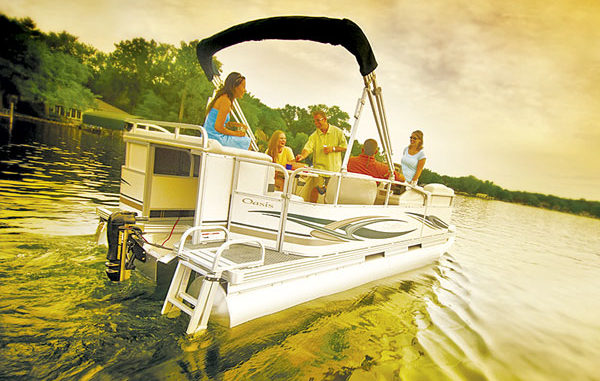
Maybe it was the $5-a-gallon gas we saw back at the beginning of the current economic slump or maybe it’s just part of the growing green movement, but the number of boat makers offering models with electric primary power instead of gas engines is amping up.
We aren’t quite there yet, but we are closing in on the day when volts and amps will become a serious alternative to gas and oil in marine propulsion.
A few years ago, I got a chance to run a full-size pontoon boat powered by Minn Kota’s E-Drive, a 48-volt primary electric motor system. It was my first time to skipper a boat larger than a skiff that didn’t have an internal combustion engine somewhere on it or in it, and when the speed reading on my handheld GPS unit passed 5 m.p.h., I was impressed.
Electric propulsion has been an option on pontoon and other boats, but its main thrust has been aimed at electric-only waters.
I started planning a project to put together a practical, all-electric fishing boat, and my first step was asking a local marine dealer’s advice on choosing an appropriate hull. The dealer picked up one of his 2010 G3 boat catalogs, and thumbed through it to the Eagle 176 Electric model. It is a 17-foot, 7-inch aluminum bass boat with Minn Kota’s E-Drive motor on the transom and 45-pound thrust Edge trolling motor on the bow, making it an all-electric fishing rig.
The boat can come equipped with six batteries: four for the E-Drive; one for electronics, pumps and accessories; and one for the bow-mounted trolling motor. An E-Drive can run wide open for about two hours on a single charge and longer at lower power settings. An angler could take along one of the new breed of generators slightly larger than a big tackle box to feed the onboard battery chargers and probably fish for a week on a gallon of gas.
A recent press release from Canadian boat builder Princecraft fired yet another torpedo into my project. Normally, boat builders create a boat first and then determine its method of propulsion, but Princecraft designed its Brio 15e and 17e pontoon boats for electric power and redesigned its 14-foot Yukon open fishing boat to better fit an electric outboard.
The 15- and 17-foot pontoons are more compact, lighter and have built-in battery storage. The Yukon DLe includes an overhead solar panel that produces enough power on a sunny day to troll at two m.p.h. and operate a fishfinder without any help from batteries.
Princecraft uses German-built Torqeedo electric outboards including the 48-volt, 4.0R model said to equal the thrust of a 9.9-horsepower gas outboard. In tests, it has pushed a well-stocked, 24-foot pontoon boat 6.1 m.p.h. with seven people aboard. An integrated computer in the Torqeedo system combines information from motor, batteries and the motor’s GPS receiver to keep boaters aware of remaining battery power and cruising range.
I may be too old and brittle to even watch wakeboarding up close, but I’m still fascinated by Epic Boats’ new hybrid electric 23e wakeboard boat. It can pull boarders for an hour or produce a massive wave for wake surfers for three hours without using a drop of gas.
Its electric drive system performs like a 375-horsepower gas engine, easily pulling boarders at 36 m.p.h. using only the juice from its lithium batteries. An onboard generator can recharge the batteries in about an hour, or be left running to keep up with battery discharge during all-day boarding sessions.
Battery weight, capacity and cost have been the anchors slowing development of electric propulsion in both the boating and automotive industries. Both Epic Boats and Torqeedo electric outboards use lighter and more efficient lithium battery technology, but it’s expensive and will remain so until it becomes more widespread.
As an example, Torqeedo is bringing a 24-volt, lithium manganese marine battery to market that weighs 44 pounds, about one-fourth what a comparable lead-acid battery system would weigh. Unfortunately, the new battery will sell for about $2,400, about four times the cost of a pair of the best 12-volt, lead-acid batteries you could find.
How will the price come down? I’m betting that widespread use will have to start in the automotive industry as more electric cars appear and then trickle down to marine users. When it does, I plan to be first in line to buy an electrifying new Mercury Volterado or Yamaha Amp Max outboard!
For more information, visit 23e.epicboats.com; g3boats.com; minnkotamotors.com; princecraft.com; torqeedo.com.


